It doesn’t seem like much would be here as we walk up the paved road featuring cartoon monkeys at each intersection. The Mandarin, Hakka and English signs — also adorned with monkeys — points to Heyao Cultural and Creative Park (和窯文創園區), which usually indicates some sort of repurposed industry site turned artsy chic hotspot. Not exactly what we’d want to see in rural Longtan (龍潭), a Hakka town in southern Taoyuan.
The neat rows of rolling tea trees soon come into view, and past that is a charming complex of wooden structures with hand painted signs that reflect the quaint, rustic surroundings. The first building sells coffee made from locally-grown beans served in hand-made ceramic wares, and we are invited to drink tea with a group of friendly locals at a cozy open-air terrace under a tree, adorned with large wooden planks calligraphed with classical poems. The place gets its name from the large wood-fire ceramic kiln, where artists take turns stoking the fire for 100 hours straight before leaving it to bake for another week.
Longtan’s favorite son, the novelist Chung Chao-cheng (鍾肇政), once lived at the bottom of the hill due to his father’s job, and the park reflects both his passion for the arts and his love for fading rural traditions. It’s a world away from the hectic bustle of downtown Longtan, and makes for an enjoyable afternoon of relaxation and exploration of the community.
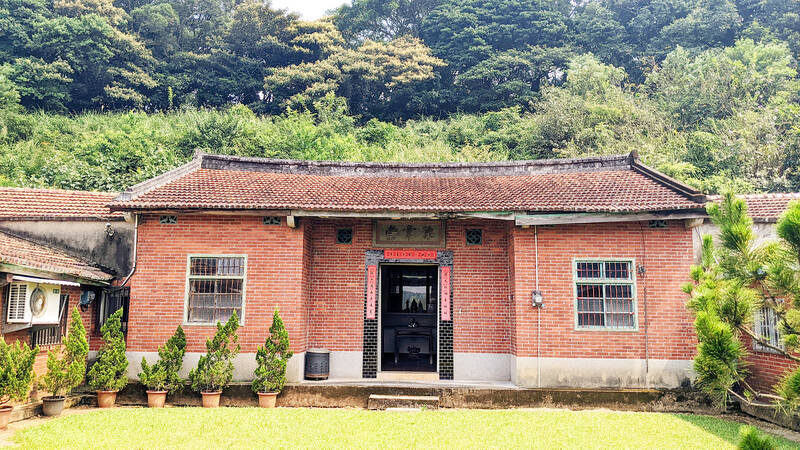
Photo: Han Cheung, Taipei Times
There are plenty of sights worth seeing in the center of Longtan, including Chung’s former residence and study, but located 6km east of town with scant public transport options, Heyao and the surrounding Sanhe Community (三和) remains a hidden gem for those who venture this way.
TRANQUIL FARMLAND
This tea-farming area of Sanchiashui (三洽水) features in Chung’s novel as a place of natural beauty, but also of much hardship. His father served as principal of nearby Sanhe Elementary School (三和國小), and Chung joined him here after World War II. There were no openings at the school, so he began working at Longtan Elementary School (龍潭國小) in 1946, making the hour-long trek daily through the hilly terrain.
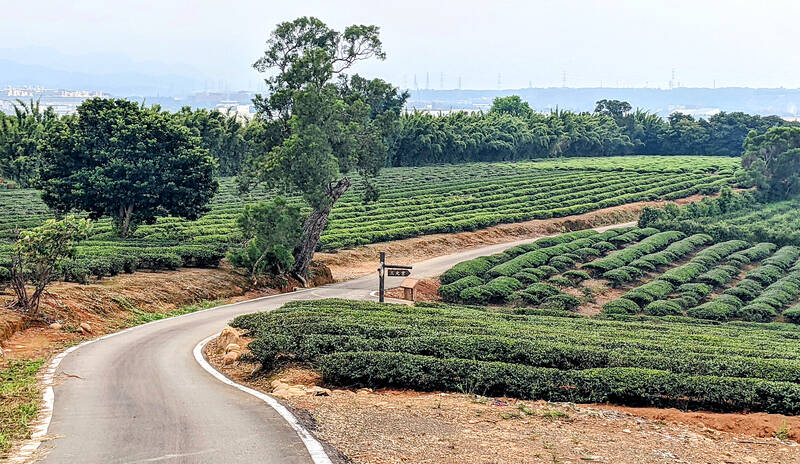
Photo: Han Cheung, Taipei Times
He looked forward to the walk at first as he fell in love with a coworker, but the courtship eventually ended due to her family’s objections. He found solace in Sanchiashui’s verdant environment, often wandering through the hills to soothe his sorrows. I wonder if I’m tracing his steps as I get lost in the winding trails and industry roads behind Heyao, where there’s not a single soul to be seen on a sweltering Saturday morning.
Visitors can trace Chung’s footsteps from Longtan to Heyao, but it’s probably ideal to drive or take a taxi due to the up and down terrain. We took YouBikes the first time we visited, and it was easy enough to get there but torturous to get back.
The entrance to the park lies at Sanyuan Temple (三元宮), which hosts the Sanhe Borough (三和) community center and a mini-bookstore. The temple worships the Three Great Emperor-Officials (三官大帝), who are in charge of the sky, water and earth realms and are thus important deities for farmers. The bottom of the hills feature lush paddies, which quickly give way to the forest and tea fields.
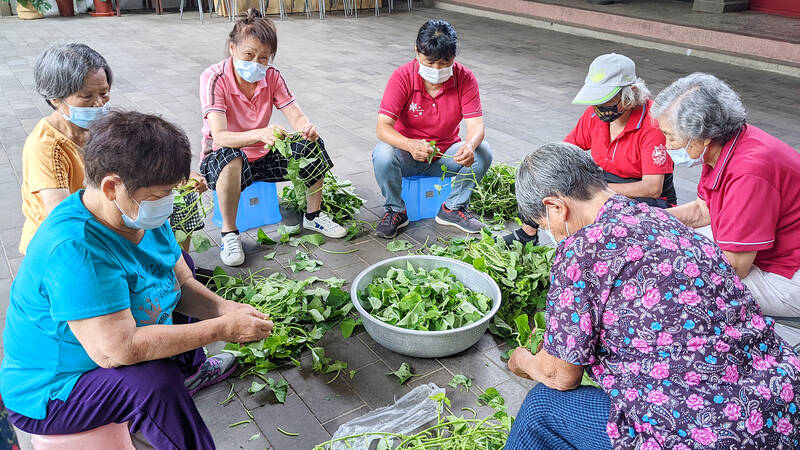
Photo: Han Cheung, Taipei Times
Hakka-language sayings with romanized pronunciation decorate the walls, while elderly residents share their home-grown produce early in the morning. Sanhe sounds like “monkey mountain” in Hakka, which explains the ubiquitous monkey motifs. The female monkeys have Tung blossoms on them, as the area is a sweet spot for watching them fall in late April and early May.
POTTERY HAVEN
After baking for 14 days, the kiln is opened on the morning of our most recent visit, with excited potters sorting and admiring tables full of wares burned into dazzling shades of orange, brownish-purple and metallic black. Heyao Cultural Creative Park was established in 2014 for environmental restoration and tourism purposes, and developed its distinct character over the years. Visitors can sign up for ceramics workshops here or at Zhenyi Pottery Studio (真一陶坊) on the other side of the river.

Photo: Han Cheung, Taipei Times
The coffee shop was born by accident; the owner tells me that she was just planning on selling crafts and other local goods, but discovered coffee growing in the hills; likely planted by previous residents. Her husband happened to grow up in the coffee-producing area of Gukeng Township (古坑) in Yunlin County, and knew how to process the beans.
After retrieving all the wares, the artists gather around Teacher Huang’s (黃) atmospheric tea space to chat. The 73-year-old Huang is a woodworker and is responsible for many of the decorations — including a ceramic amplifier from which he plays tunes from his phone. He’s also quite a storyteller, and it seems to be a popular gathering spot for locals and frequent visitors — even Longtan’s district chief shows up for a brief respite from his official duties.
If you’re hungry, there’s a wood-fired bakery next door, and if you want a fuller meal there are several Hakka-style restaurants to choose from on the main road.
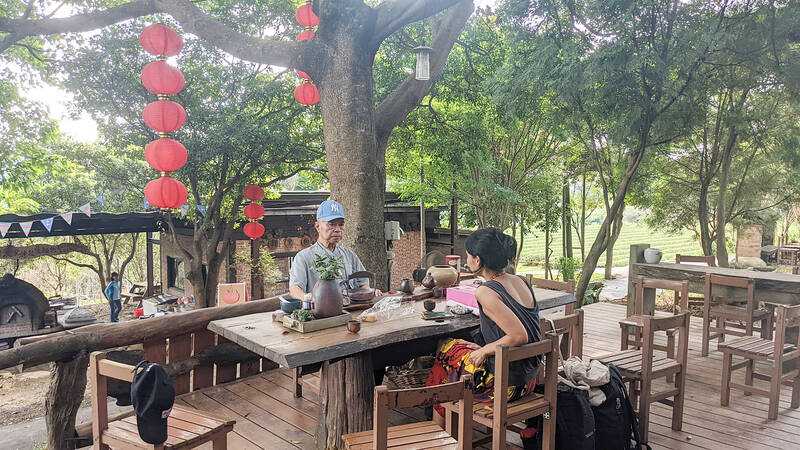
Photo: Han Cheung, Taipei Times
THE BACK HILLS
Departing from Heyao, I walk up the Shiqi Trail (石崎步道), a tree-covered path that runs between the industry road and tea fields. It’s short, tranquil and easy to traverse, and exits into a stunning panorama of vast tea fields. This area is called Fanziwo (番子窩), suggesting an indigenous past, but unfortunately there’s little information about it found on site.
Huge, ornate Hakka family graves dot the fields and hills, many of them with small brick wells and mini-Earth God shrines. Small paths branch off from the main roads, but many of them have been reclaimed by thick vegetation. Only venture in if you have ample outdoor experience. Further up the hill is the Bogonggeng Earth God Temple (伯公梗福德祠), a shiny, newly-renovated shrine that provides sweeping views of the valley (as well as the industrial complexes and factories beyond).
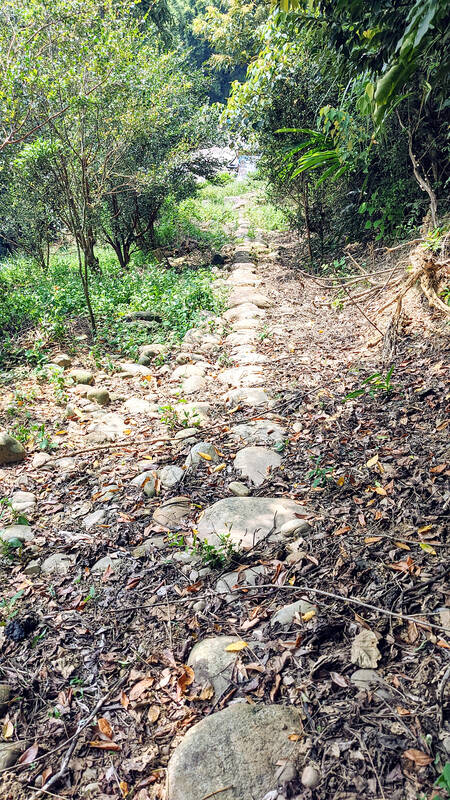
Photo: Han Cheung, Taipei Times
Visitors can walk further up to Rugushan (乳姑山), which is lined with outdoor restaurants with pretty vistas of the valleys, or continue strolling through the ambling paths. There’s a few classic three-sided red brick courtyards — the Lo House (羅屋) being the most notable, which was built by a family who settled here in 1856. There are a few signs that point toward a Chiu Residence (邱厝), but I could not find it.
There seems to be more to see in the adjacent hills, judging from Google Maps, and it would be a great excuse to come back and hang out some more at Heyao.

April 14 to April 20 In March 1947, Sising Katadrepan urged the government to drop the “high mountain people” (高山族) designation for Indigenous Taiwanese and refer to them as “Taiwan people” (台灣族). He considered the term derogatory, arguing that it made them sound like animals. The Taiwan Provincial Government agreed to stop using the term, stating that Indigenous Taiwanese suffered all sorts of discrimination and oppression under the Japanese and were forced to live in the mountains as outsiders to society. Now, under the new regime, they would be seen as equals, thus they should be henceforth

Last week, the the National Immigration Agency (NIA) told the legislature that more than 10,000 naturalized Taiwanese citizens from the People’s Republic of China (PRC) risked having their citizenship revoked if they failed to provide proof that they had renounced their Chinese household registration within the next three months. Renunciation is required under the Act Governing Relations Between the People of the Taiwan Area and the Mainland Area (臺灣地區與大陸地區人民關係條例), as amended in 2004, though it was only a legal requirement after 2000. Prior to that, it had been only an administrative requirement since the Nationality Act (國籍法) was established in

Three big changes have transformed the landscape of Taiwan’s local patronage factions: Increasing Democratic Progressive Party (DPP) involvement, rising new factions and the Chinese Nationalist Party’s (KMT) significantly weakened control. GREEN FACTIONS It is said that “south of the Zhuoshui River (濁水溪), there is no blue-green divide,” meaning that from Yunlin County south there is no difference between KMT and DPP politicians. This is not always true, but there is more than a grain of truth to it. Traditionally, DPP factions are viewed as national entities, with their primary function to secure plum positions in the party and government. This is not unusual

US President Donald Trump’s bid to take back control of the Panama Canal has put his counterpart Jose Raul Mulino in a difficult position and revived fears in the Central American country that US military bases will return. After Trump vowed to reclaim the interoceanic waterway from Chinese influence, US Defense Secretary Pete Hegseth signed an agreement with the Mulino administration last week for the US to deploy troops in areas adjacent to the canal. For more than two decades, after handing over control of the strategically vital waterway to Panama in 1999 and dismantling the bases that protected it, Washington has